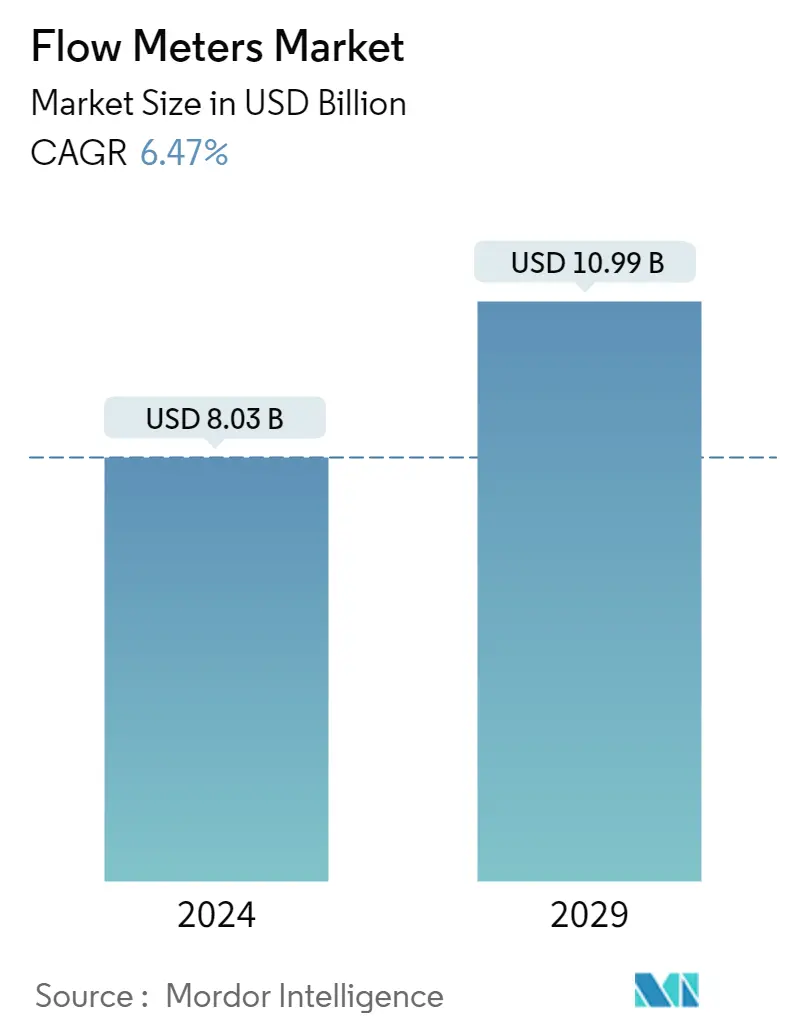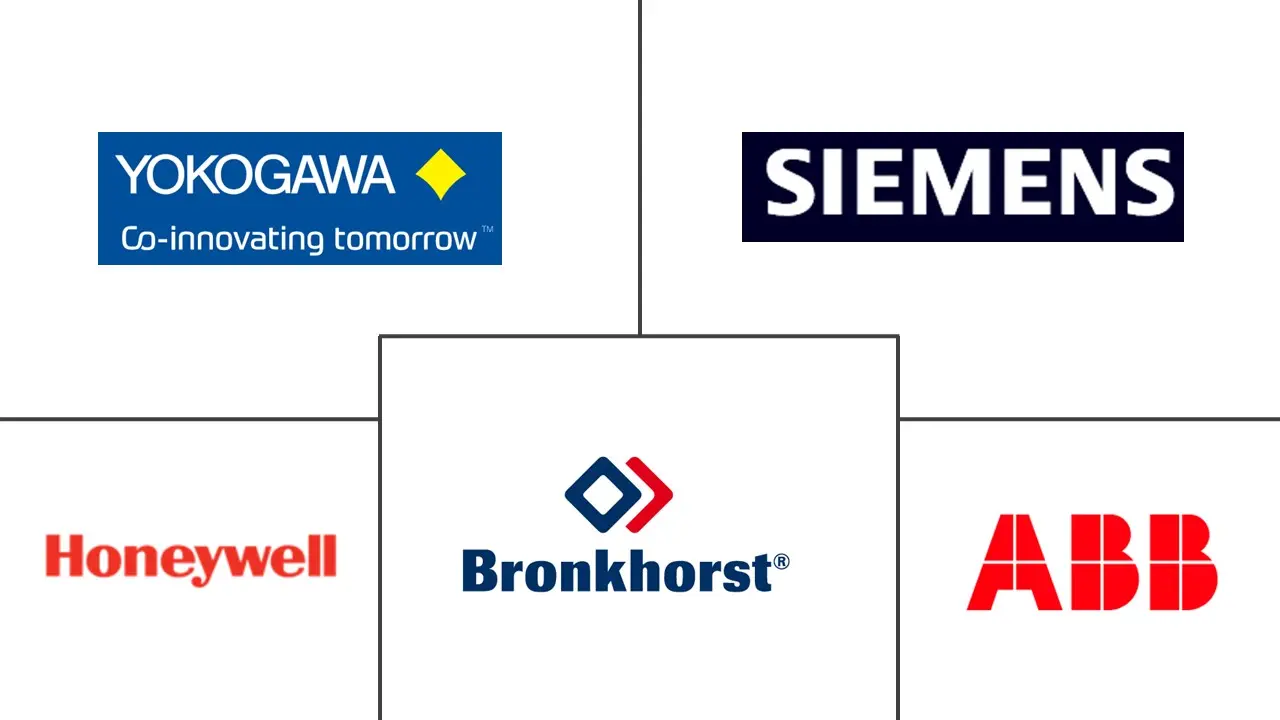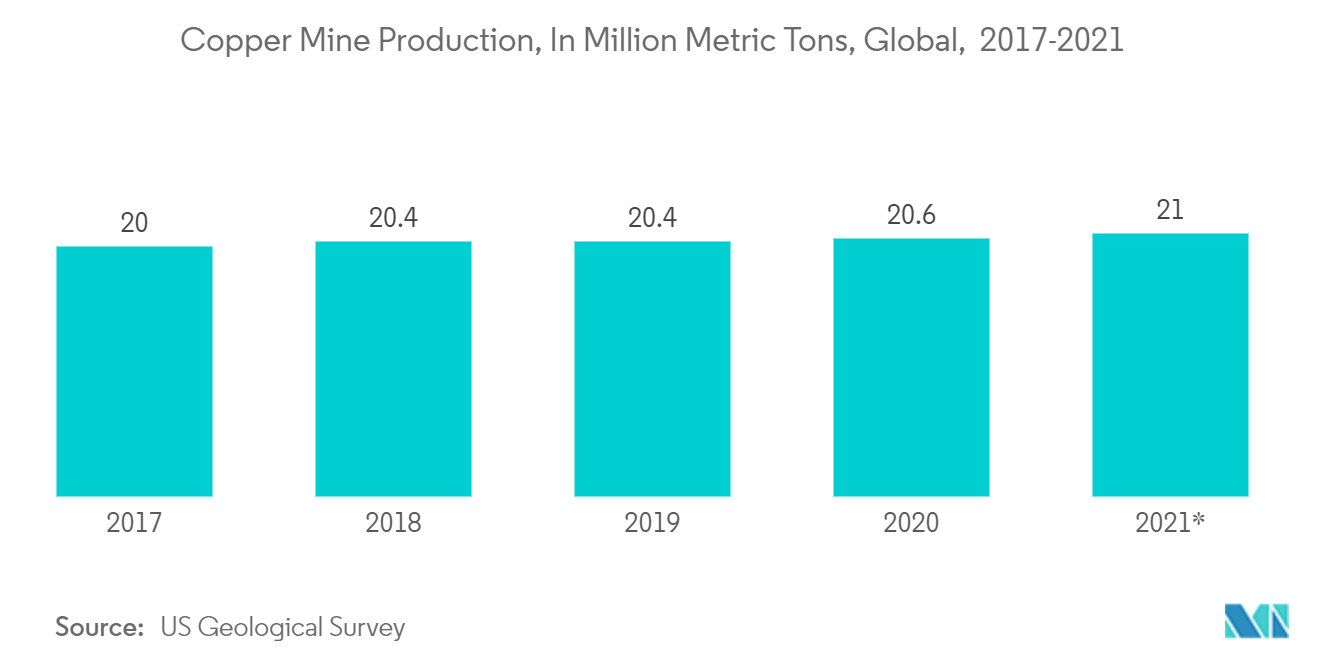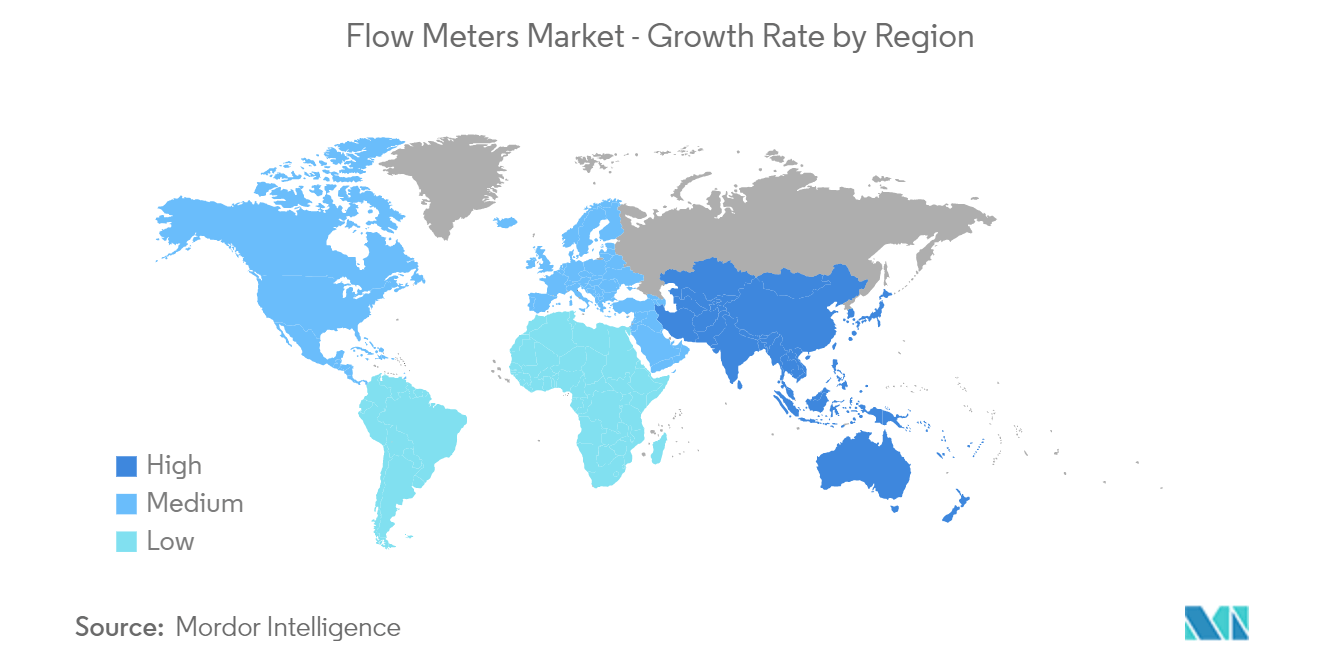Flow Meters Market Size

| Study Period | 2019 - 2029 |
| Market Size (2024) | USD 8.03 Billion |
| Market Size (2029) | USD 10.99 Billion |
| CAGR (2024 - 2029) | 6.47 % |
| Fastest Growing Market | Asia-Pacific |
| Largest Market | North America |
Major Players
*Disclaimer: Major Players sorted in no particular order |
Flow Meters Market Analysis
The Flow Meters Market size is estimated at USD 8.03 billion in 2024, and is expected to reach USD 10.99 billion by 2029, growing at a CAGR of 6.47% during the forecast period (2024-2029).
Flow meters, called flow sensors, are electronic devices that primarily measure or regulate the flow rate of liquids and gases within pipes and tubes. They are commonly used in HVAC systems, medical devices, chemical factories, and septic systems. These meters can primarily detect leaks, blockages, pipe bursts, and liquid concentration changes owing to contamination or pollution.
- The flow sensors/devices are generally connected to the gauges to render their measurements; however, they can also be connected to computers and digital interfaces. Flow meters can be divided into two groups, contact, and non-contact flow meters. Non-contact flow meters are used when the liquid or gas (generally, a food product) being monitored would be otherwise contaminated or physically altered by coming in contact with the moving parts.
- Multiple emerging technologies, such as IIoT, asset management, and advanced diagnostics, are also helping in forming new collaborations among users and suppliers. Moreover, the strategies for both end users and suppliers have been leveraging advancements in networking and cloud platforms and service offerings that include data and analytics. Flow meters are also witnessing a steady rise in the demand for monitoring and measuring the flow of steam, gas, water, chemicals, and mineral oil, among others. These meters offer essential precision regarding ideal and economic quantity during flow measurement. They offer advantages when it comes to processing control.
- Major trends in flow meter technology include digital signals for flow meters, multiple measurement formats, online diagnosis and troubleshooting, remote calibration and configuration, and smart sensors with online alerts. The technological advancements via robust research and development have also enabled the industry to develop appropriate solutions to complex operational problems. Automated cleaning is also one of the revolutionary trends observed in the market. This trend is advantageous for industries such as water and wastewater management.
- However, certain factors are projected to hinder market expansion. The existing flowmeters in the market are only sometimes compatible with modern machines and infrastructure. Therefore, there is a need to replace the existing outdated versions with newer, efficient, and compatible instruments. The expense of replacing the old instruments with the new generation of equipment might be a costly procedure. This will most certainly limit the market for Flow Meters.
- Industrial sectors, such as oil and gas, chemicals, pulp and paper, and metals and mining, were most affected due by the Covid-19 pandemic, thus witnessing a subsequent decline in the demand for products offered by these industries. However, demand significantly surged in many industrial sectors serving the pharmaceutical, energy, and utility applications. Furthermore, the pandemic also significantly fueled industrial automation adoption, resulting in increased product launches during the pandemic and innovation.
Flow Meters Market Trends
This section covers the major market trends shaping the Flow Meters Market according to our research experts:
Electromagnetic Flow Meter Holds Significant Market Share
- Electromagnetic flow meters detect flow using Faraday's law of induction. An electromagnetic coil generates a magnetic field and electrodes that capture voltage (electromotive force) within an electromagnetic flowmeter. Due to the presence of coil and electrodes, there is nothing inside the flow pipes of an electromagnetic flow meter, and flow can be measured.
- According to Faraday's law of induction, moving conductive liquids inside the magnetic field generates voltage. The inner pipe diameter, magnetic field strength, and average flow velocity are all proportional. Also, an essential difference between electromagnetic and other flow meters is that because electromagnetic flowmeters work on electromagnetic induction, conductive liquids are the only liquids for which flow can be detected.
- Electromagnetic flowmeters have a wide range of applications in food industries, chemical applications, natural gas supplies, wastewater, mining, and power utilities. They are largely unaffected by the liquid's temperature, pressure, density, and viscosity.
- According to US Geological Survey, global copper mine production amounted to an estimated 21 million metric tons in the last year. Global copper production has steadily grown over the past decade, rising from 16 million metric tons in 2010.
- Electromagnetic flowmeters start as volumetric flow devices but can measure mass flow by plugging the product's density. The density value must remain stable for accuracy. In a few cases, a density meter is also used with electromagnetic meters to provide mass flow readings.
- For instance, mining companies often use an electromagnetic flow meter to measure slurry flow with specific liners to reduce abrasion. A densimeter sends data for the electromagnetic flowmeter to translate into an online mass flow measurement. The growth in mining activities globally is encouraging the use of electromagnetic flowmeters. According to EIA, crude oil production in the United States is expected to increase in the current year by 0.4 million b/d due to increased drilling activities, leading to flow meter adoption.

North America is Expected to Register the Largest Market
- The North American region is expected to hold a significant market share, primarily owing to the significantly developed oil and gas, chemicals, and power generation industries. The North American renewable power generation industry is also expected to continue to invest significantly in new projects. According to IRENA, In the last year, the global installed renewable energy capacity will be 3.1 terawatts, a 9.3 percent increase over the previous year. The renewable energy sector has undergone an expansion over recent decades due to decreasing pricing in renewable technologies as well as concerns about the environmental impact of more traditional sources.
- Diaphragm-positive displacement meters are widely used in the United States for commercial and utility gas flow measurement, per the Pipeline and Gas Journal report published last year. These meters are often used outside restaurants and other small businesses to measure gas consumption. Larger business establishments also use diaphragm meters to measure gas consumption, although, in many cases, the utility owns the meter. Recently, rotary meters have been replacing diaphragm meters in some applications.
- Thus, to maintain the establishment and organization of the wastewater system, many companies are making strategic acquisitions to gain the technical expertise required. For instance, in May 2021, The TASI Group of Companies acquired Mission Communication and Norcross GA to complement TASI Flow's existing Asset Management and Wireless Connectivity Strategy, enabling a strong presence in the Water and Wastewater market.
- Companies are also introducing innovative digital interfaces and software solutions in the studied segment. For instance, in February 2021, Emerson launched new software that boosts process automation with the application of the Roxar 2600 Multiphase Flow Meter (MPFM) for the oil and gas industry. Its Rapid Adaptive Measurement software architecture helps the Roxar 2600 to do the parallel calculation at 10Hz and automatically select the optimal configuration for a particular time.

Flow Meters Industry Overview
The flow meters market is highly fragmented with the presence of major players like Yokogawa Electric Corporation, ABB Ltd, Siemens AG, Bronkhorst High-Tech BV, and Honeywell International Inc. Players in the market are adopting strategies such as partnerships, innovations, and acquisitions to enhance their product offerings and gain sustainable competitive advantage.
In September 2022, Yokogawa Electric Corporation announced the launch of the OpreXTM Magnetic Flowmeter CA Series. This new product series succeeded the ADMAG CA Series and was introduced as part of the OpreX Field Instruments family. The items in this new series are all capacitance-type magnetic flowmeters that can measure the flow of conductive fluids through a measurement tube without contacting the device's electrodes. This series has novel functionalities that increase user-friendliness, maintainability, and operational efficiency, in addition to the non-wetted electrode architecture.
In June 2022, Sensirion expanded its mass flow controller line with the SFC5500. The high-performance mass flow controllers and meters are calibrated for numerous gases. The feature includes push-in fittings, which the user from the list of suitable components can readily replace. Each device may cover a variety of flow ranges present in traditional devices. The SFC5500 is a flexible SFC5500 that can handle many applications.
Flow Meters Market Leaders
-
Yokogawa Electric Corporation
-
ABB Ltd
-
Siemens AG
-
Bronkhorst High-Tech BV
-
Honeywell International Inc.
*Disclaimer: Major Players sorted in no particular order

Flow Meters Market News
- October 2022: Watson-Marlow Fluid Technology Solutions (WMFTS) announced that the KROHNE FLEXMAG 4050 C electromagnetic flowmeter is available to biopharmaceutical clients. It strengthens the company's position as a provider of total-solution packages for customers adopting fluid path processes by being an exact and dependable flow measurement device that smoothly connects with other WMFTS products.
- May 2022: SONOTEC improved its SONOFLOW CO.55 non-contact flow meter to improve efficiency in PAT-related upstream and downstream biotechnology activities. The new SONOFLOW CO.55 V3.0 sensor offers exceptional measurement accuracy and the finest clamp-to-clamp repeatability.
Flow Meters Market Report - Table of Contents
1. INTRODUCTION
- 1.1 Study Assumptions and Market Definition
- 1.2 Scope of the Study
2. RESEARCH METHODOLOGY
3. EXECUTIVE SUMMARY
4. MARKET INSIGHTS
- 4.1 Market Overview
- 4.2 Industry Value Chain Analysis
-
4.3 Industry Attractiveness - Porter Five Forces
- 4.3.1 Bargaining Power of Suppliers
- 4.3.2 Bargaining Power of Consumers
- 4.3.3 Threat of New Entrants
- 4.3.4 Threat of Substitute Products
- 4.3.5 Intensity of Competitive Rivalry
- 4.4 Recent Technological Developments
- 4.5 Assessment of the Impact of COVID-19 on the Industry
5. MARKET DYNAMICS
-
5.1 Market Drivers
- 5.1.1 Penetration of IoT and Automation in Flow Rate Measurement Applications
- 5.1.2 Growing Industrial Demand regarding Safety and Efficiency Concerns
-
5.2 Market Challenges
- 5.2.1 Rising Cost With Product Advancement
6. MARKET SEGMENTATION
-
6.1 Technology
- 6.1.1 Coriolis
- 6.1.2 Electromagnetic
- 6.1.2.1 In-line Magnetic Flowmeters
- 6.1.2.2 Low Flow Magnetic Flowmeters
- 6.1.2.3 Insertion
- 6.1.3 Differential Pressure
- 6.1.4 Ultrasonic
- 6.1.4.1 Clamp-on
- 6.1.4.2 In-line
- 6.1.5 Other Technologies
-
6.2 End-user Industry
- 6.2.1 Oil and Gas
- 6.2.2 Water and Wastewater
- 6.2.3 Chemical and Petrochemical
- 6.2.4 Food & Beverage
- 6.2.5 Pulp and Paper
- 6.2.6 Other End-user Industries
-
6.3 Geography
- 6.3.1 North America
- 6.3.1.1 United States
- 6.3.1.2 Canada
- 6.3.2 Europe
- 6.3.2.1 United Kingdom
- 6.3.2.2 Germany
- 6.3.2.3 France
- 6.3.2.4 Rest of Europe
- 6.3.3 Asia Pacific
- 6.3.3.1 China
- 6.3.3.2 Japan
- 6.3.3.3 India
- 6.3.3.4 Rest of Asia Pacific
- 6.3.4 Latin America
- 6.3.5 Middle East and Africa
7. Competitive Landscape
-
7.1 Company Profiles
- 7.1.1 Yokogawa Electric Corporation
- 7.1.2 ABB Ltd
- 7.1.3 Siemens AG
- 7.1.4 Bronkhorst High-Tech BV
- 7.1.5 Honeywell International Inc.
- 7.1.6 Emerson Electric Co.
- 7.1.7 SICK AG
- 7.1.8 OMEGA Engineering
- 7.1.9 Christian Burkert GmbH & Co. KG
- 7.1.10 TSI incorporated
- 7.1.11 Keyence Corporation
- 7.1.12 Sensirion AG
- 7.1.13 Azbil Corporation
- 7.1.14 Endress+Hauser AG
- 7.1.15 Krohne Messtechnik GmbH
- *List Not Exhaustive
8. INVESTMENT ANALYSIS
9. FUTURE OUTLOOK
** Subject To AvailablityFlow Meters Industry Segmentation
Flow meters (also known as flow sensors) are devices used to measure and record the flow rate. They measure the flow rate of a fluid, liquid, or gas when it passes through a confined transmission system. There are different principles of flow meters, like orifice meters, venturi meters, rotameters, flow nozzles, etc.
The global flow meters market is segmented by technology - Coriolis, differential flow, ultrasonic, vortex, and other technologies. The scope of other technologies covers types like open channel, positive displacement, turbine, variable area, thermal mass, and MEMS.
Different industries, like oil and gas, water and wastewater, paper and pulp, chemical, power generation, and food and beverage, use a flow meter to strengthen their growth rate in their respective fields. End-user industry segment the other end-user industries segment includes semiconductors, HVAC, fuel cells, instrumentation, automotive, and other hazardous areas.
For each segment, the market sizing and forecasts have been provided based on value (in USD million) and volume (in metric tons).
| Technology | Coriolis | |
| Electromagnetic | In-line Magnetic Flowmeters | |
| Low Flow Magnetic Flowmeters | ||
| Insertion | ||
| Differential Pressure | ||
| Ultrasonic | Clamp-on | |
| In-line | ||
| Other Technologies | ||
| End-user Industry | Oil and Gas | |
| Water and Wastewater | ||
| Chemical and Petrochemical | ||
| Food & Beverage | ||
| Pulp and Paper | ||
| Other End-user Industries | ||
| Geography | North America | United States |
| Canada | ||
| Geography | Europe | United Kingdom |
| Germany | ||
| France | ||
| Rest of Europe | ||
| Geography | Asia Pacific | China |
| Japan | ||
| India | ||
| Rest of Asia Pacific | ||
| Geography | Latin America | |
| Middle East and Africa |
Flow Meters Market Research FAQs
How big is the Flow Meters Market?
The Flow Meters Market size is expected to reach USD 8.03 billion in 2024 and grow at a CAGR of 6.47% to reach USD 10.99 billion by 2029.
What is the current Flow Meters Market size?
In 2024, the Flow Meters Market size is expected to reach USD 8.03 billion.
Who are the key players in Flow Meters Market?
Yokogawa Electric Corporation, ABB Ltd, Siemens AG, Bronkhorst High-Tech BV and Honeywell International Inc. are the major companies operating in the Flow Meters Market.
Which is the fastest growing region in Flow Meters Market?
Asia-Pacific is estimated to grow at the highest CAGR over the forecast period (2024-2029).
Which region has the biggest share in Flow Meters Market?
In 2024, the North America accounts for the largest market share in Flow Meters Market.
What years does this Flow Meters Market cover, and what was the market size in 2023?
In 2023, the Flow Meters Market size was estimated at USD 7.54 billion. The report covers the Flow Meters Market historical market size for years: 2019, 2020, 2021, 2022 and 2023. The report also forecasts the Flow Meters Market size for years: 2024, 2025, 2026, 2027, 2028 and 2029.
Flow Meters Industry Report
Statistics for the 2024 Flow Meters market share, size and revenue growth rate, created by Mordor Intelligence™ Industry Reports. Flow Meters analysis includes a market forecast outlook to 2029 and historical overview. Get a sample of this industry analysis as a free report PDF download.



